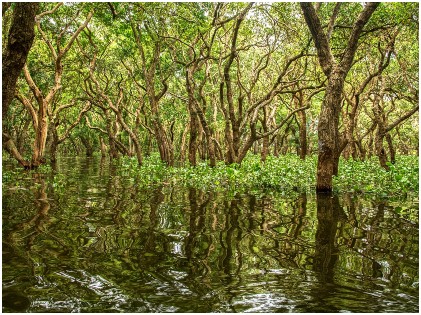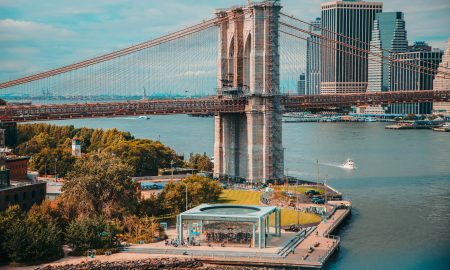
Why Scientists Are So Worried About Growth Of Ghost Forests?

Climate change is having a detrimental impact on nature and things are not looking good at all. Take the coastal areas for example. The presence of dead trees along the coastal regions throughout the planet gives clear indications of what the consequences can be if there is a rise in the sea levels. Climate change is causing coastal erosion, drought, and hurricanes regularly and if this continues, it will spell doom for coastal vegetation. Scientists have discovered forest die-offs and have already blown the whistle. The coasts are being flooded by the rising seas and saltwater is seeping into the wetlands. The salt is killing the trees and ghost forests are being left behind. What are ghost forests and why are scientists so worried about the growth of these ghost forests? Find out.
What Are Ghost Forests?
 When saltwater invades into the forests located close to the estuaries or coasts owing to the rise in sea level, it not only affects the amount of fresh water required by the deciduous trees to sustain but also poisons the trees. The dead trees in a forest make it a ghost forest. Tectonic shifts can also cause ghost forests. Earthquakes and tsunamis can alter the coastal line and create a ghost forest. Now, what is causing the sea level to rise?
When saltwater invades into the forests located close to the estuaries or coasts owing to the rise in sea level, it not only affects the amount of fresh water required by the deciduous trees to sustain but also poisons the trees. The dead trees in a forest make it a ghost forest. Tectonic shifts can also cause ghost forests. Earthquakes and tsunamis can alter the coastal line and create a ghost forest. Now, what is causing the sea level to rise?
Thermal Expansion
The emissions of greenhouse gases are causing an increase in atmospheric temperatures. A major part of this atmospheric heat is absorbed by the oceans. As a result, the water heats up, expands, and eventually occupies more space. Experts call this process a thermal expansion. And it is causing one-third of the rise in sea levels.
Melting of Glaciers
 A rise in atmospheric temperatures leads to the melting of ice sheets and glaciers. The meltwater adds to the volume of the ocean, resulting in two-thirds of the increased sea level. A study conducted in the year 2019 revealed that in case of low emissions of greenhouse gases, there will be a 30 cm rise in sea level by 2050 and a 69 cm rise in sea level by 2100. In comparison to that, the sea level will rise by 34 cm by 2050 and 111 cm by the year 2100 in a situation when the emission of greenhouse gases is high.
A rise in atmospheric temperatures leads to the melting of ice sheets and glaciers. The meltwater adds to the volume of the ocean, resulting in two-thirds of the increased sea level. A study conducted in the year 2019 revealed that in case of low emissions of greenhouse gases, there will be a 30 cm rise in sea level by 2050 and a 69 cm rise in sea level by 2100. In comparison to that, the sea level will rise by 34 cm by 2050 and 111 cm by the year 2100 in a situation when the emission of greenhouse gases is high.
Impact of Rising in Sea Level
Soil erosion, flooding, destruction of habitats, and disappearance of islands lying below sea levels are some of the consequences of a rise in sea level. The storm surges have a greater potential to cause more harm to the coastal areas, as there is an abnormal rise in the sea level at the time of a storm. And these storm surges become more powerful and can destroy every habitat and vegetation on their path when a higher sea level coincides with a hurricane.
There are lots of birds that thrive on coastal ecosystems for food, habitat, and breeding. Sea turtles lay eggs on the beaches and they make way to the same location year after year. When seawater erodes the beaches, it will hurt these birds and animals. Moreover, a rise in sea level will force people to leave their habitat. If reports are to go by, there will be around 187 climate refugees by the turn of the next century.
Impact on Coastal Vegetation
 Rising seas can prove to be a threat for nations that lie below sea level, island states, as well as coastal cities. However, as the current situation suggests, the effects of the rising seas have already started to erode coastal vegetation. The landscapes are now being dotted with ghostly dead trees which constitute a ghost forest. This is the immediate result of a rise in sea levels. The leafless, limbless, and lifeless trees can survive for several decades in this barren condition.
Rising seas can prove to be a threat for nations that lie below sea level, island states, as well as coastal cities. However, as the current situation suggests, the effects of the rising seas have already started to erode coastal vegetation. The landscapes are now being dotted with ghostly dead trees which constitute a ghost forest. This is the immediate result of a rise in sea levels. The leafless, limbless, and lifeless trees can survive for several decades in this barren condition.
The Connection with a Rise in Sea Level
Saltwater intrudes into the wetlands owing to a rise in sea level. The salt content is robbing the soil of its health, making the forests completely unsuitable for the growth of new plants. Clusters of trees are dying. Unfortunately, now new sapling is growing. In their places, one can witness the growth of salt-tolerant grasses and shrubs.
Global warming is s the primary reason behind the rise in seawater level and the subsequent invasion of land by the sea. Until and unless the greenhouse gas emissions are not kept in check, there seems to be no respite from the destruction. However, with the rising awareness about the planet, we can hope these situations will be under control in the future.
More in Business & Investments
-
`
WWE SmackDown to Make a Comeback on USA Network in 2024
In a surprising twist, WWE’s Friday night staple, “SmackDown,” is bidding farewell to Fox and heading back to its old stomping...
November 24, 2023 -
`
Why Women Face Higher Out-of-Pocket Health Expenses
In healthcare, disparities persist, and a recent report from Deloitte underscores a significant financial gap between working women and men in...
November 18, 2023 -
`
Elon Musk vs Bill Gates: The Clash of Titans
In the realm of the world’s wealthiest individuals, a simmering rivalry has been captivating public attention. It’s not a clash of...
November 7, 2023 -
`
The Power Of Disconnecting
In our digitally driven age, where smartphones, tablets, and laptops have become extensions of ourselves, disconnecting might seem daunting. However, the...
October 31, 2023 -
`
JCPenney’s Bankruptcy: The End of an Era
JCPenney filed for bankruptcy in a move echoing the struggles of many retailers in the wake of the COVID-19 pandemic. This...
October 26, 2023 -
`
Reasons Why You Need a Financial Plan
Financial planning is not just for the wealthy or those nearing retirement. It’s a crucial tool for anyone seeking financial security...
October 19, 2023 -
`
How Brad Pitt Spends His Millions All Over the World
Brad Pitt, the charismatic Hollywood superstar, has left an indelible mark on the silver screen and made an impact in the...
October 10, 2023 -
`
Gen Z’s Posh Palate: The Unexpected Rise of Caviar Culture
Amid the backdrop of a digital era buzzing with viral dances, e-sports, and niche memes, there emerges a peculiar plot twist:...
October 7, 2023 -
`
Transform Your Retail Business With Social Media Mastery
If you’re a retail marketer posting your social media messages haphazardly, you might be missing out on prime opportunities to turn...
September 26, 2023















You must be logged in to post a comment Login